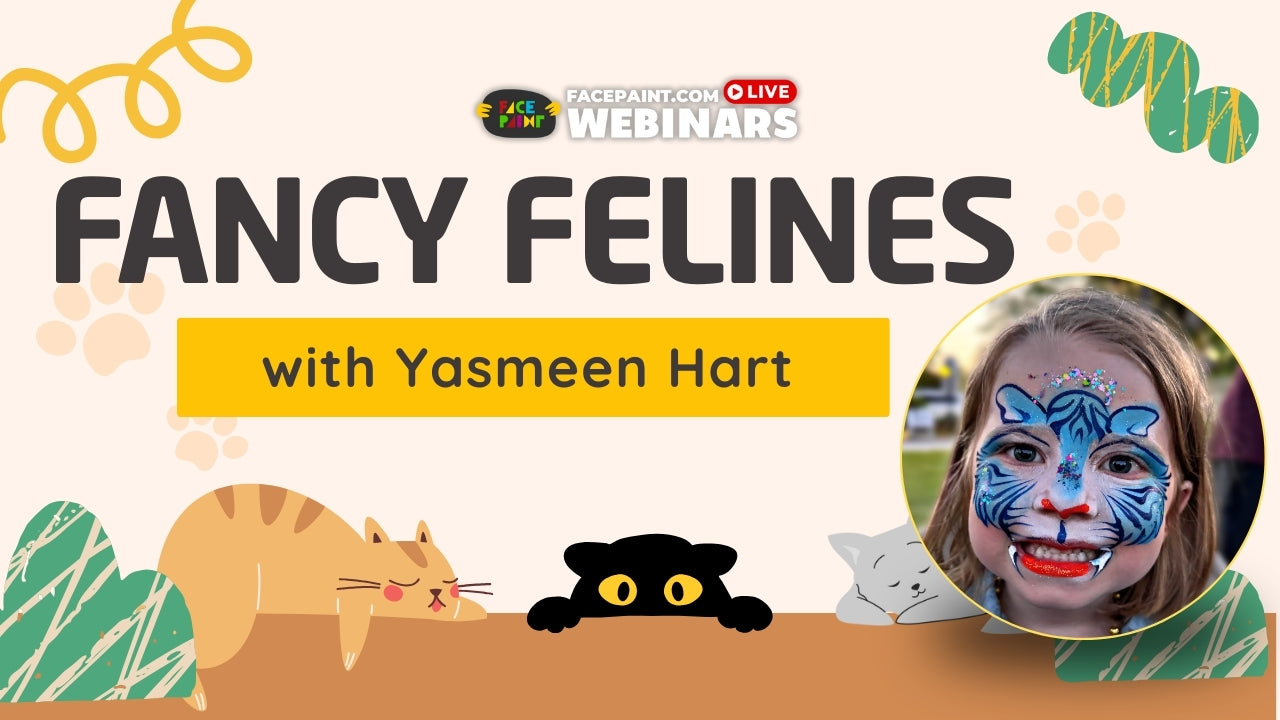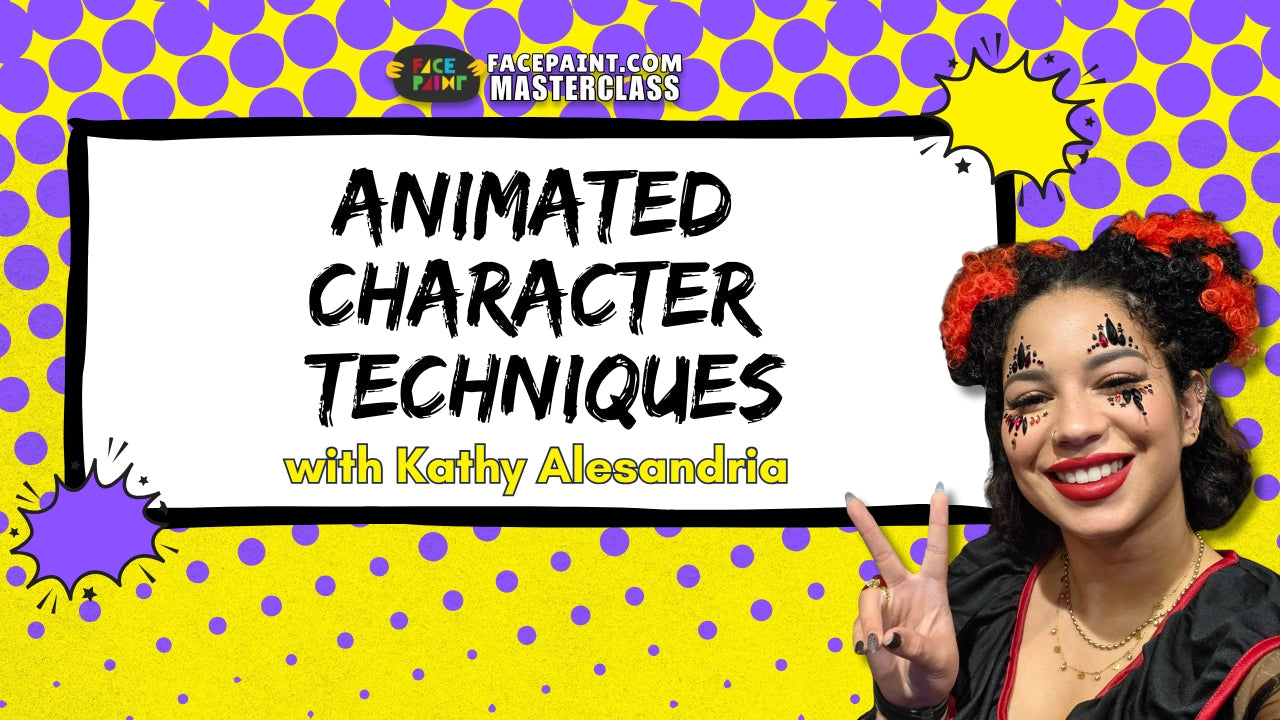Facepaint.com owner, Blake Cabot, sits down for a webinar with professional face painter Kathy Vergara, who will show us a few basic tips, tricks, and fast face paintings you can do!
Kathy has been face painting for over 8 years now, and loves what she does. Since she works for an event planning group, Kathy has taught over a hundred people how to face paint, and as you can see, she's very good at what she does!
Because she does big events, most of her designs are very fast - usually under two minutes.
When it comes to teaching, she likes to start off with the absolute basics, which are the brushes, so let's get into some brush learning!
Kathy's favorite way to paint is to use split cakes and rainbow cakes, along with flat chisel brushes.
Brushes:
- 3 1/4 inch flat brush - fits perfectly into a split cake.
- 1/2 inch brush - bristles are nice and firm, without too much give. Be sure to always use synthetic brushes.
- Filbert brush #8 from Craftsmart - great for flower petals and drawing out shapes, such as a unicorn and big tear drops.
According to Kathy, the above brushes don't give you harsh lines, as a small chisel brush would.
Kathy advises that you use one brush per color, that way your brushes are easier to maintain.
What's the Difference Between a Petal Brush and a Filbert Brush?
A filbert brush is flat and has a thick side and skinny side, while a petal brush has the same thickness all the way around - makes it easy to do petals, and small daisy flowers.
What's a Butterfly Brush?
A butterfly brush is just a regular fan brush that Kathy has cut into the shape of a butterfly wing, making it easy to load into a split cake, and put the wings down onto the skin, back and forth. She says this will really save you a lot of time.
How to Face Paint Petals and Flower Designs

In this webinar, Kathy Vergara, starts off by showing us a very quick and easy petal and flower design that anyone can do! Follow along in the video, or read the steps below to replicate this design.
Kathy almost always uses white for petals and flower designs, and this time, she's using Wolfe Face Paints in White.
Try to get a good paint consistency from the white paint, but also not too dry. You want it to be able to glide on easily, and if there's too much resistance, your paint is too dry, so add a little bit of water.
Then, use a paper towel to gently clean the tip of the brush. For this design, Kathy used TAG Dark Blue face paint. Simply dip the tip of your brush into the paint, making sure it's well saturated.
Hold the brush at almost a 90 degree angle, and push down as you go around, to make the different petals.
Usually, Kathy does about 5 petals per flower, but you can make more or less depending on your design. If for some reason you don't like the way your petals look, you can simply just go over them again.
Use a small round brush, #3 round Loew-Cornell, and dip into the white face paint. For the dots in the middle, make sure your paint is pretty wet, more liquidy
than your petals. The more pressure you put, the bigger the dots. The rounder, the prettier. The wetter the paint, the rounder the dots.
Start furthest away from where your focal point is (center of flower), push the brush down, and alternate sides (one left, one right), and go up towards
your focal point. If it starts to look streaky, reload your brush.
If you want, you can finish the design with some tear drops. Go into the focal point, the middle of the flowers. For good tear drops, your brush
should be a tiny bit on the wetter side, because if it's dry, your tear drops will look streaky.
Just push down, and drag it to where you want it to end. The more pressure you apply, the bigger the head of your tear drop will be. Put a lot of pressure in the beginning and then lift it up.
Sometimes, as you're bringing it down, you can twist it a little bit off the skin for a cool effect.
What's the Best Brush for Tear Drops?
For tear drops, Kathy uses a #3 round brush, but it all depends on the design.
For small designs, a 3 is good. If she wants to do really big tear drops, she'll use her filbert brush which would give you huge tear drops. Good for masks,
unicorn wings, or to cover a big surface area quickly.
Using Sponges for Face Painting
Kathy likes to use petal sponges for her face painting designs, specifically Paint Pals sponges, which come in a 6-pack.
Face paint sponges are great, especially for doing butterfly designs, as you can just swipe them into a split cake and apply directly above the eye and underneath the eye.
For the sponges, you want to wet your sponge, and squeeze out all the water. You Want it to be slightly damp, because you don't want your colors to run.
2 Minute Tiger Face Paint Design

This super quick tiger face paint design is a favorite of Kathy's, because not only does it look good, but it takes her just under 2 minutes to do the entire design from start to finish!
She starts off loading Paradise Paints in Orange onto a sponge. Load up your sponge with regular orange, then flip the sponge over on the skinny side, and load up with yellow. This will create a gradient effect, which is necessary for a tiger design.
The yellow face paint was pretty dry, so she added a bit more water, which will pick up the paint a lot better.
When using a sponge, don't drag, just pounce or dab onto the skin, back and forth. You'll know the sponge is loaded properly when you get a nice color gradient.
If there are bald spots, that means your paint is too dry. If there's dripping, then the paint is too wet.
Make a V shape at the forehead, come around, and go right under the eye
and cheek area, making another V shape there. One on each side of the face.

Cover the nose area using the tip of the sponge.
If you're face painting on a baby or toddler, try to stay away from the eye area. On an older child or adult, have them close their eyes, and go all the way down to the eyelid.
Now use a #8 filbert brush, and load it with white face paint. Make flicking motions, just to keep the edge of the white, and do the same thing on the other side of the face.
Bring the paint out just past the natural lip line and cover that space. Add a couple of teeth, turn the brush so that the skinny side goes downwards, and ends in a point.
If you were to add glitter, you'd do it now. Glitter looks better when you can see the black line work.

Take another filbert brush, size 8 also - the one Kathy uses is Simply Simmons. Take some black paint - the one she uses is FAB Superstar in Black.
This black is good for line work, nice and opaque. According to Kathy, it's not as
good as Wolfe would be, but it's a close second!
When doing the tiger stripes, you want to make sure that when you finish loading the brush, you flatten the bristles, so that the edge is very thin, to make sure you get precise, thin lines.
Make a thin line, apply pressure, wiggle it a little bit, and then make it thin again. Thin to thick to thin.
Start with the eyes, thin, around the eyes, over the white paint. Do the same on the other side of the face. Apply black around the eyes, as if applying eyeliner.
For the nose, it's just two tiny little tear drops. Apply black around the muzzle area and bring it up towards the nose lines.
Paint some lines across on the muzzle (the white paint). Start on the forehead, and paint lines down on the center. Add a couple more lines on each side.
You want to make sure all the tips are going down towards the focal point of the face (which is the middle of the face).

On the side of the face, start underneath the eyes and go up, one in the middle, and one that goes down towards the mouth. Repeat on other side of the face.
You can stop your design here, or, you can add a few more things. She likes to add a few random dots onto the face. The more pressure, the bigger the dots. For the dots, Kathy used a smaller round brush, Loew-Cornell #4.
Don't forget to put glitter on, if using, before doing your black line work. And always do it while your paint (the base) is still damp, so that the glitter can stick on. And there you have it! A 2-minute face paint tiger design!
Viewers Q&A
What do You Use to Hold Your Paint Brushes?

Kathy really loves her gecko holder, as it keeps your brushes separate, so you don't have them touching at all, which if they do, can transfer colors.
When you wet your sponges, do you use a spray bottle or just dip it in water?
She usually just dips the sponges into water, but a spray bottle is good
to make sure your sponge doesn't get too wet.
I've been face painting for 9 months now, how fast should I be with a design like this (tiger)?
It all depends on you, but she does it often, and it's one of her go-to's, so she can do it in under 2 minutes, so long as she has her brushes and sponges loaded up. If you're just starting, you should be able to do this design in 4 minutes.
If you have high volume events where you have to paint a large
amount of children, you'll have to be fast.
At one event, Kathy had to face paint 50 kids in an hour. She gave each child 4 options. The kids got to choose between a butterfly, a flower, a shark and a spider.

She used her butterfly brush for one of them and the Autumn Arty Brush Cake split cake and went back and forth with her butterfly brush.
Just dab the loaded brush, bounce it a little, flip it over and do the same thing on the other side. You now have your butterfly outline! Load a liner brush with black face paint and outline the butterfly wings, add antennae and body.
Do you add stencils to your designs?
Kathy doesn't use it for her type of work, but knows a lot of people who do. She has to work too fast to use a stencil, which is more time consuming.
What glitter do you use?
Mama Clown Famous Glitter. It's an iridescent white, so it goes with everything.
Does the glitter get in the way of painting over?

No, it doesn't get in the way at all, you're only using a little bit, and this glitter is very tiny. Use only cosmetic grade glitter. If you put glitter on TOP of your black line work, it takes away from the design, and you lose the detail.
How do you get stains out of sponges?
It's usually a losing battle, because moist stains never really come out. Kathy usually uses only hot water and dish soap. If the stains are really bad, she'll use laundry detergent like Tyde or Oxy Clean. Some people actually wash their sponges in a washing machine, using a mesh lingerie bag.
Do you use chunky glitter on the face?
Kathy has small jars of chunky glitter that she'll occasionally use. Dip the brushes in water and dip into the chunky glitter, and just place it onto the skin. She only uses it for special occasions, if a design really calls for it, or it's a child's birthday.
I'm always looking for fast boy designs other than Marvel, do you have any suggestions?
Kathy rarely ever does Marvel designs, but she does tigers, sharks (using a
blue split cake), which takes her 1 minute and a half to do. Spiders are also super fast!
My swirls always look wonky, and never elegant. Why is that?
Kathy advises to work on keeping constant pressure and practice on your arm - it's a lot easier. Do them quickly - the faster you do them, the more
even your line work will be. If you sketch them, they'll look broken and not very elegant.
Child and Adult Butterfly Face Paint Design

For this design, Kathy uses a sponge and a rainbow cake. This one is Pearl Peace Rainbow cake. She likes to keep lighter colors for the middle of the design.
Go back and forth with the sponge in the cake - you want it to be pretty dry.
Ask your client to close their eyes, and lay the sponge on the eye (try to "cut" the eyebrow in half), and bounce the sponge and flip it, so you're right under the eye. The focal point of the butterfly is the inner corner of the eye, so try to keep it in a triangle shape.

Make sure there's a space left on the side of the face, in between the two wings, so you actually make a butterfly shape. Repeat shape on other side of the face.
Make sure it's mostly dry before you go in with the line work, otherwise the
colors will mix in.
For a super basic butterfly, start your black line work with a tear drop at the top, and bring it around the shape of the wings. Be sure your lines are very sharp at the ends.
Dot some white paint on the black outline (the thicker ends). Kathy does varying sizes, and again, the more pressure, the bigger the dots.
Add some swirls and tear drops to the other side of the face, for a more intricate/adult design.
Finally, using a #4 brush, put 3 tear drops in the middle of the face (see above image).
On behalf of everyone here at FacePaint.com, we'd like to thank Kathy for showing us how to do high speed face painting and also thank you to all who joined on Facebook Live and on Zoom!
Stay tuned for our next webinar!
 FREE SHIPPING FOR USA ORDERS OVER $100
FREE SHIPPING FOR USA ORDERS OVER $100








Leave a comment (all fields required)